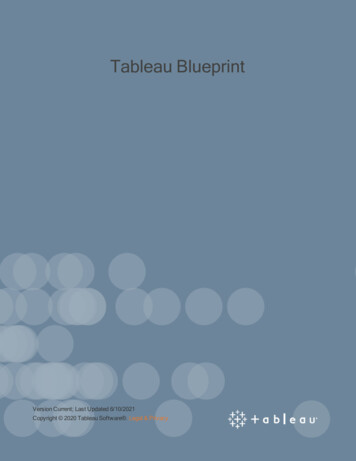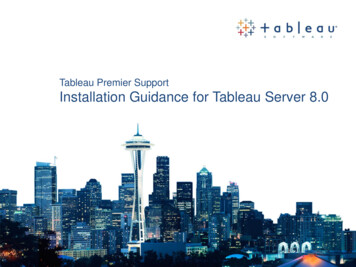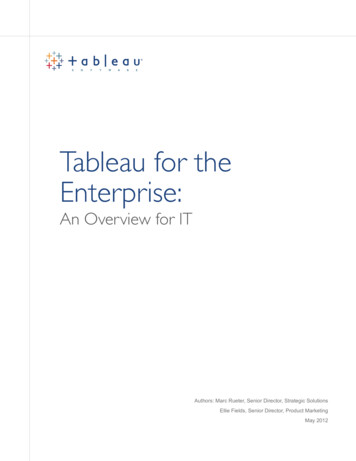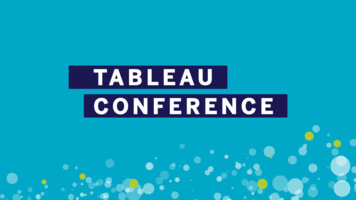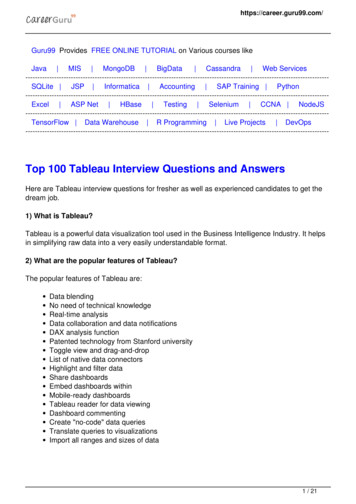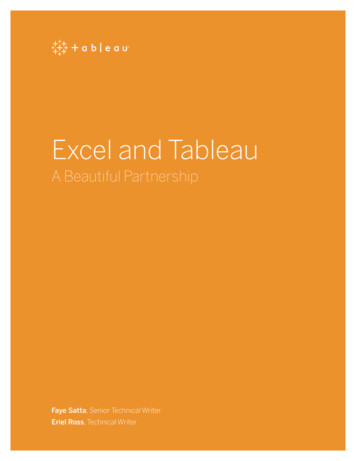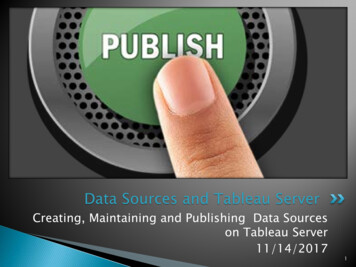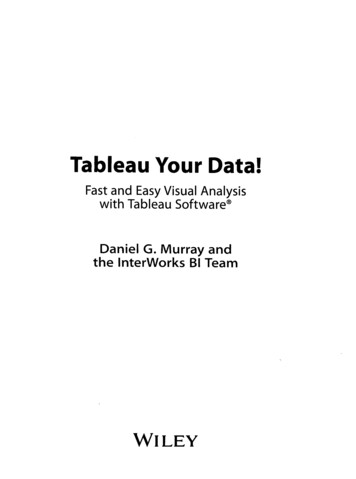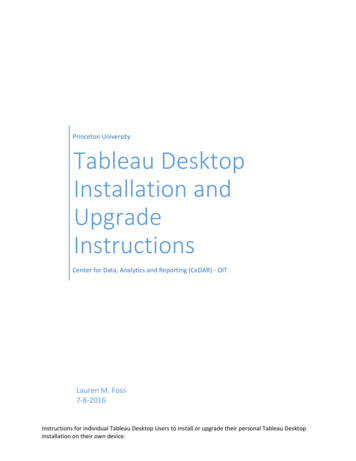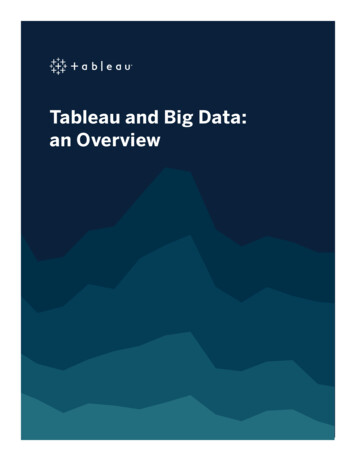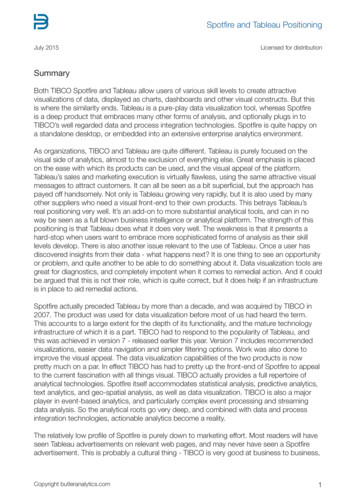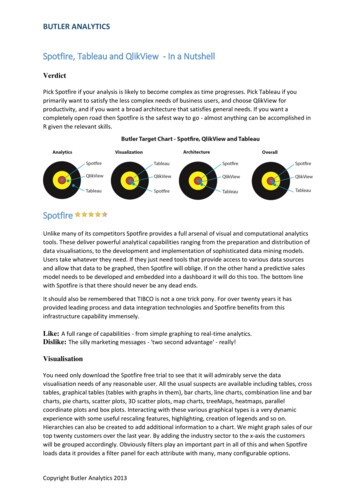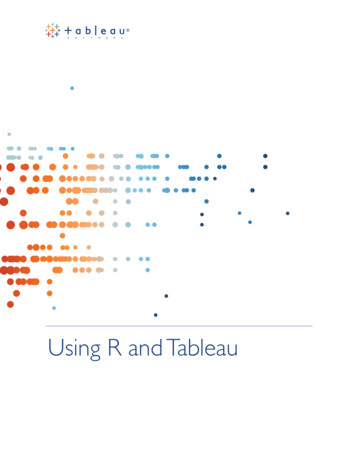
Transcription
Using R and Tableau
2Table of ContentsWhat is R?.3What are the benefits of using R?.3How is Tableau integrating with R?.5Who is this feature intended for?.5What R capabilities are available in Tableau 8.1?.6Does this mean Tableau can now do Predictive Analytics?.7What R capabilities are not available in Tableau 8.1?.7How do I start using Tableau with R?.8Are there more resources I can utilize to learn R?.9
3What is R?R is a popular statistical language used to perform sophisticated statisticalanalysis and predictive analytics, such as linear and nonlinear modeling, statisticaltests, time-series analysis, classification, clustering, etc.The R-console primarily utilizes a command-line interface, but there are manysR is a free software environmentfor statistical computing andgraphics. It compiles and runs ona wide variety of UNIX platforms,Windows and MacOS.GUI tools available for download to make it easier to write R programs (mostof them are free). With R, users can create variables, formulas, functions, andgraphs to visualize their analysis and predictions.As a free, open-source language, there is a community of contributors whocontinually create new packages (extensions) for R that define advancedstatistical functions that were not originally built in to R. These packages can bedownloaded into R to expand R’s capabilities. Most of these packages are alsodeveloped and made available for free. It is for this reason that R has become sopopular and why it continues to gain functionality over time.What are the benefits of using R?R provides a powerful way to do statistical analysis on large sets of data. It is alsofree, which is a compelling factor to its growth. Because it is open source, newfunctions and packages are created all the time, so if you can’t find a capabilityinitially, you can search for a package that can do it or even create a package ofyour own.However, there are some limitations to R as well. In order to be as flexible as it is,R leverages a command-line interface and uses its own programming languageand syntax. It does require some aptitude in coding to take advantage of the manyfunctions. Other non-free, proprietary statistics packages often have graphicaluser interfaces that are much more friendly and do not require programmingskills.¹ These solutions are intended for those users who are not as apt to learnthe R programming language, or do not need the sophisticated capabilities thatare possible with R.¹ For example, Rattle is a purpose-built GUI for data mining.
4How is Tableau integrating with R?R functions and models can now be used in Tableau by creating new calculatedfields that dynamically invoke the R engine and pass values to R. The results arethen returned back to Tableau for use by the Tableau visualization engine.K-Means Clustering with R and TableauSepal length864SpeciesI. setosa2I. versicolorI. virginica0Sepal width43210024Petal length60.0 0.51.0 1.5 2.0Petal width² RServe is a free R server and can be installed locally on a desktop or laptop computer.See below for more information on RServe.2.5
5Who is this feature intended for?This feature is primarily targeted for users who are already proficient at R. It isNOT meant for beginners with R. Anyone who wishes to use the new functionsmust first learn how to use R in order to leverage its capabilities in Tableau.Users who are already proficient with R will find the integration beneficialfor several reasons: They will be able to do statistical analysis on their Tableau data. They will be able to access any R package or function that has been installedin an R server which they can access. They will be able to take advantage of all of the visualization capabilitiesin Tableau to further analyze and understand their data without having tomanipulate their data in R (which can be cumbersome) for the same effect.Pre-requisites for using the feature include: Users must have proficiency with the R language to write the appropriatescripts and functional calls they require. Users must have access to an R server to access R functions fromTableau Desktop or Tableau Server.²² RServe is a free R server and can be installed locally on a desktop or laptop computer.See below for more information on RServe.
6What R capabilities are available in Tableau 8.1?Tableau Desktop:There are four new built-in functions that are used to call specific R models andfunctions. The functions are: SCRIPT REAL SCRIPT STR SCRIPT INT SCRIPT BOOLThese functions are distinct only in the type of result they return: a real number, astring, an integer, or a Boolean.The arguments you pass into each of these functions include R-language scriptsand function calls. You can pass 1 or more arguments to R, which are then passeddynamically via Tableau. For instance, you can pass the sales of each customer on a viz.When using Desktop, you will need to have an R server (via Rserve³) that Tableau canaccess to successfully call the new functions.Tableau Server:Tableau Server must be able to communicate with your R server in order forworkbooks with R function calls to work. When this is done, you can share workbooksand views with others while still incorporating the results from the R calculations. Ifthere is no R server running that Tableau Server can access, then these workbookswill not be able to show the correct output.Tableau Online and Tableau Public:At the current time, Tableau Online and Tableau Public are not supporting R, so the Rstatistical capabilities will not be available through these services.³ What is Rserve? Rserve allows other programs to use facilities of R (see http://www.r-project.org)without the need to initialize R or link against an R library. Rserve supports remote connection,authentication and file transfer. Typical use is to integrate R backend for computation of statisticalmodels, plots etc. in other applications.
7Does this mean Tableau can now do Predictive Analytics?Tableau already provides several built-in predictive capabilities such as trendingand forecasting. Tableau 8.1 improves forecasting by allowing you to showprediction bands with adjustable levels of certainty, as well as forecast multiplemeasures per pane. Users can use forecasting models with fiscal calendars. Inaddition, new multiplicative models have been added to give more precision inforecasts.Several R packages provide advanced predictive modeling capabilities, whichTableau customers can now leverage with the new integration in Tableau 8.1.What R capabilities are not available in Tableau 8.1?Tableau can only integrate with R through the calculated functions describedabove. This means there are several core capabilities of R that users will not beable to utilize directly in Tableau itself. You cannot export data from Tableau into R directly to run a new modeloutside of using the SCRIPT * functions. Visualizations created in R cannot be imported directly into Tableau. However,image files of R visualizations or URLs to R visualizations may be used inTableau dashboards. You cannot import datasets from R into Tableau. You can only get data fromR through the SCRIPT * functions within calculated fields. You can, however,use R and export data via a supported data source (ex: CSV) and thenvisualize that data in Tableau.
8How do I start using Tableau with R?For users who are already familiar with R and its capabilities, it is fairly simpleto establish the connection between R and Tableau. The instructions below arefor new installations using the open-source version of R. Other options may beavailable using other packages, such as those from Revolution Analytics.1.Download and Install R. Click here to find the file and instructionson downloading R.2.Download and Install Rserve. You will need to install an Rserve for Tableauto connect to in order to utilize the new script functions. In the R console,enter the following rve)Rserve()3.Connect Tableau to the R Server. Once Rserve is installed, open TableauDesktop and follow the steps below:a.Go to the Help menu and select “Manage R Connection”.b.Enter a server name of “Localhost” (or “127.0.0.1”) and a port of “6311”.c.Click on the “Test Connection” button to make sure everything runs smoothly.You should see a successful message. Click OK to close.4.Start using the R scripts in Tableau. Now you will be able to create newcalculated fields in Tableau Desktop that utilize the SCRIPT * functions tomake R functional calls.
9About TableauTableau Software helps people see and understand data. Tableau helps anyone quickly analyze,visualize and share information. More than 15,000 customer accounts get rapid results with Tableauin the office and on-the-go. And tens of thousands of people use Tableau Public to share data intheir blogs and websites. See how Tableau can help you by downloading the free trial atwww.tableausoftware.com/trial.Are there more resources I can utilize to learn R?Yes, there are several additional resources that may be helpful in getting startedwith R and leveraging its capabilities in Tableau.Learning RThe R Project for Statistical ComputingR Tutorial: An R Introduction to StatisticsIntro to R by Google DevelopersR Training TutorialsCoursera: Data and Statistics Courses, and Computing for Data Analysis (Jan 2014)Book: Software for Data AnalysisStack Overflow Q&AR Scripts RepositoryBlogs about what people are doing with RTableau and R (Blogs)TableauLove: How to configure Tableau Server to use RTableau Blogs: Tableau 8.1 and RJennifer Underwood: How to visually analyze R predictive models in TableauData Plus Science: Geocoding addresses directly in Tableau 8.1 using integration with RTableau and Tableau Software are trademarks of Tableau Software, Inc. All other company and productnames may be trademarks of the respective companies with which they are associated.
About Tableau Tableau Software helps people see and understand data. Tableau helps anyone quickly analyze, . R Training Tutorials Coursera: Data and Statistics Courses, and Computing for Data Analysis (Jan 2014) Book: Software for Data Analysis Stack Overflow Q&A R Scripts Repository Blogs about what people are doing with R Tableau and R (Blogs) TableauLove: How to configure Tableau Server .
